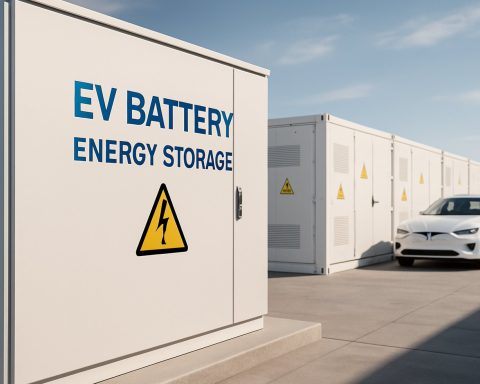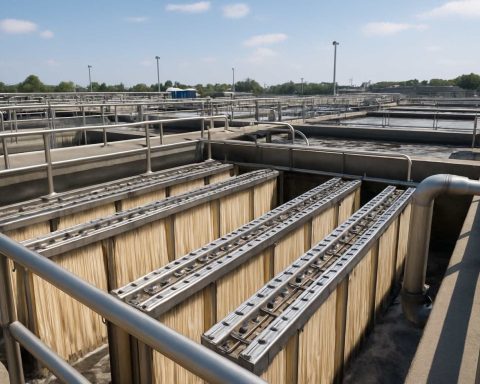- The global energy transition faces challenges due to political and economic shifts, slowing the move from fossil fuels to renewables.
- Innovations like China’s floating solar farm highlight potential for renewable energy, yet political changes, such as those under President Trump, pivot back towards fossil fuels.
- The COP28 conference marked a symbolic shift towards ending fossil fuel reliance, but differing government priorities impact progress.
- Companies like BP and Shell are reassessing their green strategies in favor of immediate oil and gas profits, reflecting market uncertainties.
- Despite setbacks, public demand and structural needs for renewables suggest a continued push for sustainable energy solutions.
- The path forward requires balanced and consistent energy policies to guide global transition efforts amid shifting political landscapes.
A new era dawned with the ambitious promise of a greener tomorrow, yet today, political shifts and economic challenges have cast shadows on the global energy transition. The picture-perfect ambition to swap fossil fuels for renewable sources now faces turbulent winds. At the forefront of innovation, a floating solar farm glistens on a flooded coal mine in Huainan, China. This eco-marvel, sprawling over 400 soccer fields, powers 100,000 homes, standing as a testament to potential yet unmet.
The tide turning momentarily at the 2023 United Nations Climate Change Conference (COP28) declared the symbolic beginning of a fossil fuel era’s end. Nations united in voice to pivot energy systems toward a renewable future. However, as 2025 ushers in fresh governmental ideologies, the steadfast march toward sustainability hits stumbling blocks.
The familiar clang of drilling and the rhythmic hum of oilfields find renewed encouragement. Political tides, with President Donald Trump at the helm in the United States, have invigorated fossil fuels once more. His administration’s bold return to oil signals a detour from the eco-conscious path tread by his predecessor. One could argue for the inevitability of this cyclical nature – a pendulum of policy that never truly settles.
Yet, you may ask, hasn’t the green cause crescendoed too loudly to be dismissed? The world’s climate-savvy population cries out for change, urging governments to solidify their green pledges. Such clamor suggests the trajectory isn’t reversing, merely slowing. Study by study, including those from the International Energy Agency (IEA), illustrate fleeting commitments swaying markets, but the structural demand for renewables remains hopeful.
Big oil, eyeing profit margins as much as any public responsibility, shuffles its focus. BP and Shell recalibrate, re-evaluating green pursuits vis-à-vis fossil investments. The promise of brisk oil and gas returns entices with a compelling narrative of assured short-term gains, leaving broader green ventures in shadows. For instance, as Shell retraces its renewable steps in New Jersey, investors ponder the nuanced dance between profitability and sustainability.
This isn’t an outright energy confrontation; it’s more a recalibration under the weight of political and economic discord. The key takeaway is this: while policy shifts and economic urgencies tug us away from renewable goals, they do not uproot the seeds already planted. Indeed, the global energy transition doesn’t waltz in a straight line but chess-moves cautiously forward, ducking through the mire of political weather.
In this saga of ambition and deferral, the takeaway echoes clearer than ever: we must champion steady, balanced policymaking. To truly galvanize this energy evolution, policymakers worldwide need wield steadiness in policy as one would a lighthouse guiding ships amid a tempest.
Unveiling the Future: Navigating the Complex Path of the Global Energy Transition
Understanding the Complex Dynamics of the Energy Transition
The current global energy transition, while promising a sustainable future, faces an intricate web of political and economic challenges. Exploring beyond the surface of this transition reveals a multifaceted landscape where renewable energy initiatives, such as the floating solar farm on a reclaimed Chinese coal mine, are juxtaposed against resurging fossil fuel investments.
How-To Steps for a Successful Energy Transition
1. Diversify Energy Infrastructure: Countries must invest in a blend of renewable energy sources like wind, solar, hydropower, and geothermal to ensure reliability and sustainability.
2. Encourage Technological Innovation: Support research and development in renewable technologies to enhance efficiency and reduce costs. Innovations in energy storage, for example, can help stabilize intermittent renewable sources.
3. Implement Progressive Policy Measures: Governments need to enact policies that incentivize sustainable practices, such as tax breaks for renewable energy investments and penalties for carbon emissions.
4. Facilitate Cross-Border Collaborations: International cooperation in sharing technologies and strategies can accelerate progress towards a global clean energy future.
5. Educate and Empower Consumers: Increase public awareness about the benefits of renewable energy, encouraging individual and corporate sustainability efforts.
Real-World Use Cases and Market Forecasts
– Floating Solar Farms: Apart from China’s floating solar innovation, Japan and The Netherlands have adopted similar projects, demonstrating the scalability and adaptability of solar technology in various environments.
– Market Projections for Renewables: According to the International Energy Agency (IEA), renewable energy could account for nearly 95% of the power capacity increase globally through 2025, showcasing a robust growth trajectory.
Reviews & Comparisons: Renewable vs. Fossil Energy
– Renewables: Known for sustainability and lower environmental impact, renewables are increasingly cost-competitive. Wind and solar have seen substantial decreases in production costs, making them viable alternatives to traditional energy sources.
– Fossils: Fossil fuels continue to offer reliable energy output and have established infrastructures, but they face growing regulatory pressures and environmental scrutiny.
Controversies & Limitations
– Political Influences: Shifts in government can significantly alter energy policies, as seen with the Trump administration’s support for fossil fuels.
– Economic Barriers: High upfront costs and infrastructure challenges can hinder rapid deployment of renewable technology, though decreasing costs are mitigating these challenges.
Pros & Cons Overview
Pros of Renewables:
– Environmental benefits
– Declining costs
– Energy independence
Cons of Renewables:
– Intermittency issues
– Land use concerns
– Initial investment costs
Pros of Fossils:
– Stable energy output
– Existing infrastructure
– Short-term economic benefits
Cons of Fossils:
– Environmental degradation
– Finite resources
– Increasing regulatory restrictions
Security & Sustainability
Investments in smart grid technology and distributed energy systems enhance security and efficiency. Emphasizing sustainability leads to long-term economic resilience and environmental health.
Insights & Predictions
Predictably, while the energy landscape remains dynamic and uncertain, the transition to cleaner energy sources is undeniably an entrenched global trend. Despite temporary policy reversals, market forces and societal demands will continue to drive the shift towards renewables.
Actionable Recommendations:
– Invest in Green Technology: Businesses should incorporate sustainable practices in their operations to build resilience against regulatory changes and market demands.
– Monitor Policy Developments: Stay informed on government energy policies to anticipate changes affecting industry operations and investments.
– Support Energy Education: Advocate for education initiatives that highlight the advantages and mechanics of renewable energy.
For those looking to delve deeper into these topics, more information can be found at the International Energy Agency and other credible sources focused on energy economics and policy.











